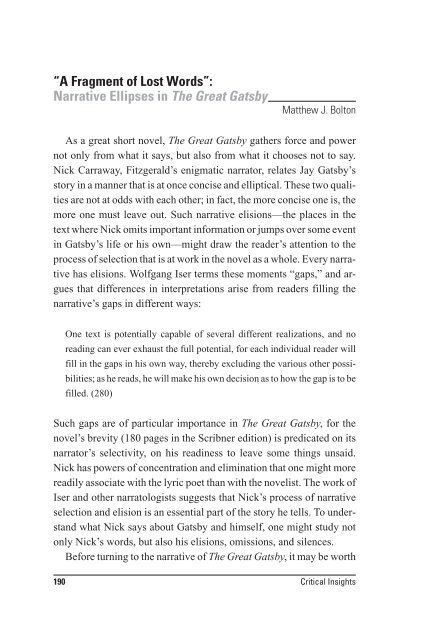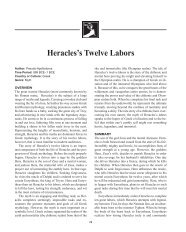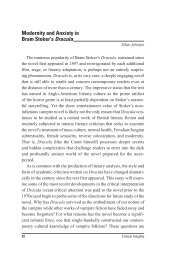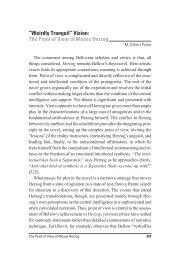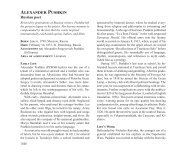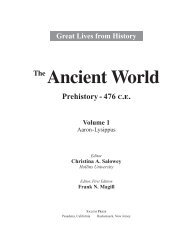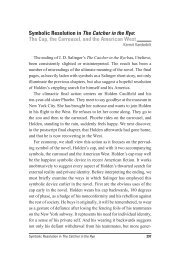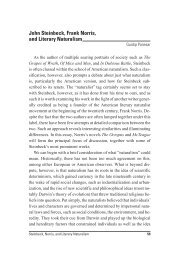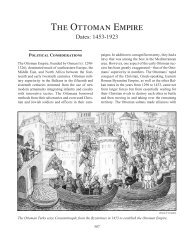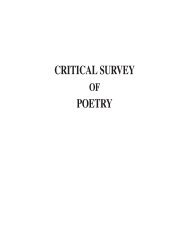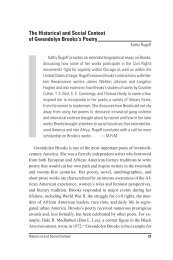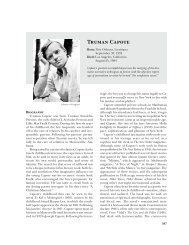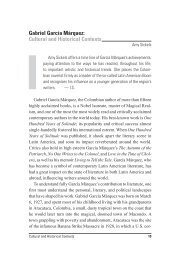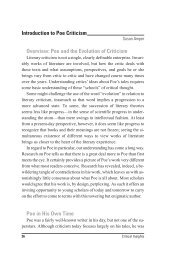“A Fragment of Lost Words”: Narrative Ellipses in The ... - Salem Press
“A Fragment of Lost Words”: Narrative Ellipses in The ... - Salem Press
“A Fragment of Lost Words”: Narrative Ellipses in The ... - Salem Press
You also want an ePaper? Increase the reach of your titles
YUMPU automatically turns print PDFs into web optimized ePapers that Google loves.
<strong>“A</strong> <strong>Fragment</strong> <strong>of</strong> <strong>Lost</strong> <strong>Words”</strong>:<br />
<strong>Narrative</strong> <strong>Ellipses</strong> <strong>in</strong> <strong>The</strong> Great Gatsby Matthew J. Bolton<br />
As a great short novel, <strong>The</strong> Great Gatsby gathers force and power<br />
not only from what it says, but also from what it chooses not to say.<br />
Nick Carraway, Fitzgerald’s enigmatic narrator, relates Jay Gatsby’s<br />
story <strong>in</strong> a manner that is at once concise and elliptical. <strong>The</strong>se two qualities<br />
are not at odds with each other; <strong>in</strong> fact, the more concise one is, the<br />
more one must leave out. Such narrative elisions—the places <strong>in</strong> the<br />
text where Nick omits important <strong>in</strong>formation or jumps over some event<br />
<strong>in</strong> Gatsby’s life or his own—might draw the reader’s attention to the<br />
process <strong>of</strong> selection that is at work <strong>in</strong> the novel as a whole. Every narrative<br />
has elisions. Wolfgang Iser terms these moments “gaps,” and argues<br />
that differences <strong>in</strong> <strong>in</strong>terpretations arise from readers fill<strong>in</strong>g the<br />
narrative’s gaps <strong>in</strong> different ways:<br />
One text is potentially capable <strong>of</strong> several different realizations, and no<br />
read<strong>in</strong>g can ever exhaust the full potential, for each <strong>in</strong>dividual reader will<br />
fill <strong>in</strong> the gaps <strong>in</strong> his own way, thereby exclud<strong>in</strong>g the various other possibilities;<br />
as he reads, he will make his own decision as to how the gap is to be<br />
filled. (280)<br />
Such gaps are <strong>of</strong> particular importance <strong>in</strong> <strong>The</strong> Great Gatsby, for the<br />
novel’s brevity (180 pages <strong>in</strong> the Scribner edition) is predicated on its<br />
narrator’s selectivity, on his read<strong>in</strong>ess to leave some th<strong>in</strong>gs unsaid.<br />
Nick has powers <strong>of</strong> concentration and elim<strong>in</strong>ation that one might more<br />
readily associate with the lyric poet than with the novelist. <strong>The</strong> work <strong>of</strong><br />
Iser and other narratologists suggests that Nick’s process <strong>of</strong> narrative<br />
selection and elision is an essential part <strong>of</strong> the story he tells. To understand<br />
what Nick says about Gatsby and himself, one might study not<br />
only Nick’s words, but also his elisions, omissions, and silences.<br />
Before turn<strong>in</strong>g to the narrative <strong>of</strong> <strong>The</strong> Great Gatsby, it may be worth<br />
190 Critical Insights
def<strong>in</strong><strong>in</strong>g narratology itself. Narratology might be thought <strong>of</strong> as an<br />
emerg<strong>in</strong>g field <strong>of</strong> study, a critical approach to literature, film, and other<br />
media that coalesces around Roland Barthes’writ<strong>in</strong>gs <strong>of</strong> the 1960s and<br />
Wayne Booth’s sem<strong>in</strong>al 1961 study, <strong>The</strong> Rhetoric <strong>of</strong> Fiction. Yet one<br />
could also trace the discussion <strong>of</strong> narrative elements back to Aristotle’s<br />
writ<strong>in</strong>g on drama, see<strong>in</strong>g the work <strong>of</strong> Barthes, Booth, and their contemporaries<br />
as cont<strong>in</strong>u<strong>in</strong>g a conversation that is several millennia <strong>in</strong> the<br />
mak<strong>in</strong>g. <strong>The</strong> early twentieth-century writ<strong>in</strong>gs <strong>of</strong> the Russian formalists,<br />
notably Vladimir Propp and Mikhail Bakht<strong>in</strong>, both <strong>of</strong> whose work began<br />
to appear <strong>in</strong> English translation <strong>in</strong> the 1970s, are likewise vital to this<br />
conversation. Narratologists also draw on the reflections and theories<br />
<strong>of</strong> English and American novelists, such as E. M. Forster and Henry<br />
James. Narratology is therefore a polyglot and heterogeneous school<br />
<strong>of</strong> theory. Its practitioners take a magpie’s approach to literary criticism,<br />
mak<strong>in</strong>g use <strong>of</strong> whatever material serves their needs.<br />
It is appropriate that narratology should be a heterogeneous mode <strong>of</strong><br />
criticism, for the literary form that is most commonly its subject—the<br />
novel—is itself pr<strong>of</strong>oundly heterogeneous. <strong>The</strong> novel is a mixed form,<br />
one that, <strong>in</strong> the hands <strong>of</strong> a good writer, is pliable, <strong>in</strong>clusive, and expansive.<br />
Its formal elements are so loosely def<strong>in</strong>ed as to seem <strong>in</strong>f<strong>in</strong>itely responsive<br />
to the warp and wo<strong>of</strong> <strong>of</strong> its themes and its subject matter. Its<br />
very name speaks <strong>of</strong> its “newness”; every great novel is a novelty. To<br />
see how widely novels vary <strong>in</strong> structure, one need only compare a collection<br />
<strong>of</strong> novels to a collection <strong>of</strong>, say, sermons, sonnets, fairy tales, or<br />
epics. Narratology may <strong>in</strong> fact be a response to the heterogeneous nature<br />
<strong>of</strong> the novel; it is an attempt to f<strong>in</strong>d a common language for discuss<strong>in</strong>g<br />
commonalities across radically different novels. <strong>The</strong> narratologist’s<br />
focus on literary elements (such as plot or sett<strong>in</strong>g), on the<br />
representation <strong>of</strong> time and action, and on the relationships among author,<br />
narrator, character, and reader might be seen as an effort to develop<br />
a poetics <strong>of</strong> fiction.<br />
Narratologists <strong>of</strong> all stripes would make a series <strong>of</strong> dist<strong>in</strong>ctions between<br />
author and narrator and between the text <strong>of</strong> the novel and the<br />
<strong>“A</strong> <strong>Fragment</strong> <strong>of</strong> <strong>Lost</strong> <strong>Words”</strong> 191
world that the text describes. In the case <strong>of</strong> <strong>The</strong> Great Gatsby, Nick<br />
Carraway is not F. Scott Fitzgerald—even if Carraway has at his disposal<br />
the full range <strong>of</strong> Fitzgerald’s lyrical powers and even if he, like<br />
Fitzgerald, uses those powers to tell Gatsby’s story. This dist<strong>in</strong>ction between<br />
author and character is an elementary one that most students<br />
learn by the time they enter high school. <strong>The</strong> second narratological dist<strong>in</strong>ction,<br />
on the other hand, is a bit more subtle, requir<strong>in</strong>g that critics<br />
settle on some common terms. In the world which Nick Carraway <strong>in</strong>habits,<br />
a series <strong>of</strong> events occurred <strong>in</strong> the summer <strong>of</strong> 1922—and <strong>in</strong> the<br />
years lead<strong>in</strong>g up to that summer—that ultimately led to Jay Gatsby’s<br />
death. <strong>The</strong>se events, as listed chronologically and causally, might be<br />
termed the story: Gatsby meets Daisy, loses her to the wealthy Tom<br />
Buchanan, resolves to re<strong>in</strong>vent himself as a wealthy and powerful man,<br />
follows her east to Long Island, buys a house across the bay from her,<br />
prevails upon Nick to reunite him with Daisy, and so on and so forth.<br />
<strong>The</strong> story is the sequence <strong>of</strong> events <strong>in</strong> the order <strong>in</strong> which they occurred<br />
<strong>in</strong> the “real” (albeit fictional) world.<br />
Yet many novels, Gatsby among them, do not follow this chronological<br />
order. Rather, they represent (notice the literal orig<strong>in</strong> <strong>of</strong> the word:<br />
re-present, to show aga<strong>in</strong>) the story accord<strong>in</strong>g to some other organiz<strong>in</strong>g<br />
pr<strong>in</strong>ciple. <strong>The</strong> order <strong>in</strong> which a given text represents its story might be<br />
termed the “narrative discourse.” <strong>The</strong> dist<strong>in</strong>ction between story and<br />
discourse becomes clear when one th<strong>in</strong>ks <strong>of</strong> a prototypical mystery<br />
novel, where the identity <strong>of</strong> the murderer and motive for his or her<br />
crime—<strong>in</strong> other words, the events that set the story <strong>in</strong> motion—are not<br />
revealed until the end <strong>of</strong> the novel. In a similar ve<strong>in</strong>, <strong>The</strong> Great Gatsby<br />
does not beg<strong>in</strong> with Gatsby meet<strong>in</strong>g Daisy, but rather with Nick mov<strong>in</strong>g<br />
to Long Island. Because Nick is the novel’s narrator, he presents <strong>in</strong>formation<br />
on Gatsby <strong>in</strong> the order <strong>in</strong> which it was revealed to him.<br />
Charles Baxter calls this “the Ishmael Pr<strong>in</strong>ciple,” after the narrator <strong>of</strong><br />
Moby Dick, posit<strong>in</strong>g: “Gatsby can’t tell his story, so Nick Carraway<br />
does ...Gatsby doesn’t have the necessary distance on his own situation<br />
even to beg<strong>in</strong> to narrate it” (42). Baxter speculates about how un-<br />
192 Critical Insights
fail<strong>in</strong>gly bland and ridiculous Gatsby’s own memoir, were he able to<br />
write one, would be. Nick br<strong>in</strong>gs to Gatsby’s story the right degree <strong>of</strong><br />
<strong>in</strong>volvement and detachment; he has the poet’s ability, as Shelley put it<br />
<strong>in</strong> his “to see life steadily and see it whole.”<br />
Yet <strong>in</strong> order to see Gatsby’s story steadily and whole, Nick must exclude<br />
from his narrative almost everyth<strong>in</strong>g that does not speak <strong>of</strong><br />
Gatsby and his world. He glosses over many <strong>of</strong> the quotidian details<br />
that would have comprised his life and occupied his m<strong>in</strong>d dur<strong>in</strong>g<br />
his time <strong>in</strong> New York City and on Long Island. <strong>The</strong> specifics <strong>of</strong> his<br />
bond-<strong>of</strong>fice job, the girl from Jersey City whom he dates for awhile,<br />
and any number <strong>of</strong> similar <strong>in</strong>cidents are given only m<strong>in</strong>imal attention.<br />
Some novels are omnibus constructions, like the sprawl<strong>in</strong>g multi-plot<br />
Victorian works that Henry James termed “loose and baggy monsters.”<br />
A three-volume Dickens or Thackeray novel can expand to <strong>in</strong>corporate<br />
multiple plot l<strong>in</strong>es, <strong>in</strong>cidents, and moods. Fitzgerald’s novel, however,<br />
functions accord<strong>in</strong>g to a very different aesthetic. <strong>The</strong> Great<br />
Gatsby is a study <strong>in</strong> concentration <strong>of</strong> effect and unity <strong>of</strong> form. Fitzgerald<br />
was well aware <strong>of</strong> the process <strong>of</strong> selection by which he constructed<br />
his novel. Reflect<strong>in</strong>g on his process <strong>of</strong> composition <strong>in</strong> a personal letter,<br />
he wrote, “<strong>in</strong> Gatsby I selected the stuff to fit a given mood <strong>of</strong><br />
‘hauntedness’ or whatever you might call it, reject<strong>in</strong>g <strong>in</strong> advance <strong>in</strong><br />
Gatsby, for <strong>in</strong>stance, all the ord<strong>in</strong>ary material <strong>of</strong> Long Island” (Fitzgerald<br />
1963, 550–51). See<strong>in</strong>g life whole requires one to focus wholly on<br />
the life one is see<strong>in</strong>g: Gatsby’s, <strong>in</strong> this case. If a particular aspect <strong>of</strong> life<br />
on Long Island did not fit <strong>in</strong>to this vision, Fitzgerald’s narrator would<br />
simply omit it.<br />
Yet Nick’s narrative selectiveness derives not only from his desire to<br />
tell Gatsby’s story, but also from his war<strong>in</strong>ess <strong>of</strong> tell<strong>in</strong>g his own. At<br />
times, Nick’s guardedness makes him what critic Wayne Booth termed<br />
“an unreliable narrator.” Because he himself is so closely <strong>in</strong>volved<br />
with the story he tells, Nick has an <strong>in</strong>terest <strong>in</strong> leav<strong>in</strong>g gaps between his<br />
narrative discourse and the “real” story. This is particularly true when<br />
the topic turns to his own biography. Early <strong>in</strong> the novel, his cous<strong>in</strong><br />
<strong>“A</strong> <strong>Fragment</strong> <strong>of</strong> <strong>Lost</strong> <strong>Words”</strong> 193
Daisy says, “We heard that you were engaged” (19). Nick’s response is<br />
typically elliptical, after which he tells the reader:<br />
Of course I knew what they were referr<strong>in</strong>g to, but I wasn’t even vaguely engaged.<br />
<strong>The</strong> fact that gossip had published the banns was one <strong>of</strong> the reasons<br />
I had come East. You can’t stop go<strong>in</strong>g with an old friend on account <strong>of</strong> rumors,<br />
and on the other hand I had no <strong>in</strong>tention <strong>of</strong> be<strong>in</strong>g rumored <strong>in</strong>to marriage.<br />
(19)<br />
This is a marvelously laconic description <strong>of</strong> a love affair turned sour.<br />
Had Daisy not asked after his rumored engagement, it seems likely<br />
Nick would not have mentioned it at all. One could argue that Nick recognizes<br />
that his failed affair is only tangentially related to the story he<br />
tells, and that he therefore relates it <strong>in</strong> a concise manner. Yet the <strong>in</strong>cident<br />
may be more important to Nick than he lets on to his reader. That<br />
Nick has fled <strong>in</strong> the face <strong>of</strong> rumors that he was to marry a woman raises<br />
a host <strong>of</strong> questions about his own role <strong>in</strong> the relationship, about his<br />
character, and about the set <strong>of</strong> <strong>in</strong>terests and preoccupations that he<br />
br<strong>in</strong>gs not only to his budd<strong>in</strong>g relationship with Jordan Baker, but to<br />
his relationship with Jay Gatsby as well. <strong>The</strong>re is an <strong>in</strong>terplay between<br />
his own story and Gatsby’s, for both men have come from the Midwest<br />
to New York because <strong>of</strong> women: Nick <strong>in</strong> flight from one, Gatsby <strong>in</strong><br />
pursuit <strong>of</strong> another.<br />
Nick is similarly laconic when talk<strong>in</strong>g about his war experience. He<br />
mentions it <strong>in</strong> pass<strong>in</strong>g as his excuse for not attend<strong>in</strong>g Tom and Daisy’s<br />
wedd<strong>in</strong>g, but it is Gatsby who really <strong>in</strong>troduces Nick’s World War I experience<br />
<strong>in</strong>to the discourse. His first question to Nick, the two men not<br />
hav<strong>in</strong>g yet been <strong>in</strong>troduced, relates directly to the topic: “‘Your face is<br />
familiar,’ he said, politely, ‘Weren’t you <strong>in</strong> the Third Division dur<strong>in</strong>g<br />
the war?’” (47). As with the engagement, it is not at all clear whether<br />
the topic <strong>of</strong> Nick’s service would have made its way <strong>in</strong>to the narrative<br />
had someone else not <strong>in</strong>troduced it. Though he faithfully records<br />
Gatsby’s question, Nick summarizes their subsequent conversation:<br />
194 Critical Insights
“We talked for a moment about some wet, gray little villages <strong>in</strong><br />
France” (47). Aspir<strong>in</strong>g writers are <strong>of</strong>ten given the advice to show, not<br />
tell. One could imag<strong>in</strong>e the students <strong>in</strong> a fiction writ<strong>in</strong>g workshop object<strong>in</strong>g<br />
to Nick’s l<strong>in</strong>e as an example <strong>of</strong> “tell<strong>in</strong>g,” and suggest<strong>in</strong>g that<br />
the author ought to “show” the two veterans discuss<strong>in</strong>g their war stories.<br />
In not mention<strong>in</strong>g the specific towns the men talked <strong>of</strong> and the action<br />
they saw, Nick deflates this open<strong>in</strong>g conversation with Gatsby. Of<br />
course, this is precisely the effect Nick <strong>in</strong>tends: he is uncomfortable<br />
be<strong>in</strong>g at the center <strong>of</strong> the story (or narrative discourse, to be precise),<br />
and moves the discourse speedily over the events that illum<strong>in</strong>ate his<br />
own story rather than Gatsby’s.<br />
Nick is acutely observant and accurate <strong>in</strong> chronicl<strong>in</strong>g the dreams<br />
and desires <strong>of</strong> the people around him, and it is not entirely wrong for<br />
him to claim, “Every one suspects himself <strong>of</strong> at least one <strong>of</strong> the card<strong>in</strong>al<br />
virtues, and this is m<strong>in</strong>e: I am one <strong>of</strong> the few honest people that I have<br />
ever known” (59). Yet he is far less scrupulous when it comes to the<br />
facts <strong>of</strong> his own story. Biographical details <strong>of</strong> his life enter the text only<br />
because other characters ask after them. In his conversations with<br />
Daisy and Gatsby, Nick f<strong>in</strong>ds himself <strong>in</strong> a narrative double-b<strong>in</strong>d: while<br />
he would prefer to omit <strong>in</strong>formation about himself, he feels bound<br />
faithfully to represent the conversations he has had with his cous<strong>in</strong> and<br />
his neighbor. Nick’s strategy, therefore, is to summarize and compress<br />
his responses to these questions so as to give them as little space <strong>in</strong> the<br />
discourse as possible. Hav<strong>in</strong>g seen this process at work twice, the<br />
reader ought to beg<strong>in</strong> wonder<strong>in</strong>g what else Nick has chosen to omit<br />
from his narrative, what else might come to light if only someone were<br />
to ask him about it.<br />
One might chalk these omissions up to modesty, were it not for<br />
Nick’s tak<strong>in</strong>g a similar approach when he and Tom come upon the<br />
scene <strong>of</strong> the car accident toward the novel’s climax. Nick, who has always<br />
been reticent to talk about himself, chooses not to talk to the police<br />
or to Wilson <strong>of</strong> what he knows. Assum<strong>in</strong>g the role <strong>of</strong> passive witness,<br />
he allows Tom to deflect Wilson’s suspicions away from himself<br />
<strong>“A</strong> <strong>Fragment</strong> <strong>of</strong> <strong>Lost</strong> <strong>Words”</strong> 195
and onto the owner <strong>of</strong> the yellow car—Gatsby. Tom lies by omission,<br />
say<strong>in</strong>g “That yellow car I was driv<strong>in</strong>g this afternoon wasn’t m<strong>in</strong>e—do<br />
you hear? I haven’t seen it all afternoon” (140). In po<strong>in</strong>t <strong>of</strong> fact, Tom<br />
has seen the car and knows who was driv<strong>in</strong>g it: either Gatsby or Daisy.<br />
Tom’s <strong>in</strong>sistence that he doesn’t own the car is irrelevant. Yet Nick<br />
says noth<strong>in</strong>g to naysay Tom’s assertion; he simply watches and listens<br />
as Tom tells the lie that will eventually lead to Gatsby’s murder. Perhaps<br />
this should not come as a surprise, for Nick has always seemed to<br />
th<strong>in</strong>k that he can omit the truth without compromis<strong>in</strong>g his basic honesty.<br />
Jordan Baker will challenge Nick on these grounds dur<strong>in</strong>g their<br />
last conversation. Rebuff<strong>in</strong>g him for “throw<strong>in</strong>g her over,” Jordan says,<br />
“I thought you were rather an honest, straightforward person. I thought<br />
it was your secret pride” (177). Nick’s response, “I’m thirty . . . I’m five<br />
years too old to lie to myself and call it honor” (177), is equivocal.<br />
Does he mean to deny or confirm her charge? And if break<strong>in</strong>g <strong>of</strong>f his<br />
relationship with Jordan was an act <strong>of</strong> honesty, then was <strong>in</strong>itiat<strong>in</strong>g the<br />
relationship <strong>in</strong> the first place an act <strong>of</strong> dishonesty?<br />
Other gaps <strong>in</strong> Nick’s narrative may stem not from his unwill<strong>in</strong>gness<br />
to talk about himself, but rather from his <strong>in</strong>ability to do so. One such<br />
episode comes at the conclusion <strong>of</strong> the chapter <strong>in</strong> which Nick has spent<br />
the afternoon and even<strong>in</strong>g dr<strong>in</strong>k<strong>in</strong>g heavily at the Upper West Side<br />
apartment Tom keeps for his mistress, Myrtle. At the end <strong>of</strong> the even<strong>in</strong>g,<br />
Nick rides down <strong>in</strong> the elevator with Mr. McKee, who <strong>in</strong>vites him<br />
to “come to lunch some day”:<br />
<strong>“A</strong>ll right,” I agreed, “I’ll be glad to.”<br />
...Iwasstand<strong>in</strong>g beside his bed and he was sitt<strong>in</strong>g up between the<br />
sheets, clad <strong>in</strong> his underwear, with a great portfolio <strong>in</strong> his hands.<br />
“Beauty and the Beast...Lonel<strong>in</strong>ess . . . Old Grocery Horse . . . Brook’n<br />
Bridge. . .”<br />
<strong>The</strong>n I was ly<strong>in</strong>g half asleep <strong>in</strong> the cold lower level <strong>of</strong> the Pennsylvania<br />
Station, star<strong>in</strong>g at the morn<strong>in</strong>g Tribune, and wait<strong>in</strong>g for the four o’clock<br />
tra<strong>in</strong>. (38)<br />
196 Critical Insights
To return to Iser’s theory <strong>of</strong> narrative <strong>in</strong>exhaustibility, how a reader<br />
fills <strong>in</strong> the gap between Nick’s conversation <strong>in</strong> the elevator (“I’ll be<br />
glad to”) and his f<strong>in</strong>d<strong>in</strong>g himself <strong>in</strong> the bedroom <strong>of</strong> the undressed<br />
Mr.McKee(“...Iwasstand<strong>in</strong>g beside his bed”) will make a great deal<br />
<strong>of</strong> difference to one’s <strong>in</strong>terpretation not only <strong>of</strong> this scene but <strong>of</strong> the<br />
novel as a whole. Are Nick’s ellipses a form <strong>of</strong> self-censorship, by<br />
which he elides a homosexual encounter—or perhaps only the possibility<br />
<strong>of</strong> one—with McKee? Or do the ellipses mimic the gaps <strong>in</strong> the memory<br />
that can result from dr<strong>in</strong>k<strong>in</strong>g too much? Nick would certa<strong>in</strong>ly not<br />
be the only person <strong>in</strong> this novel to suffer alcohol-<strong>in</strong>duced blackouts.<br />
In his primer on narrative theory, H. Porter Abbot dist<strong>in</strong>guishes between<br />
narrative gaps and narrative cruxes: “In criticism, a crux is an<br />
<strong>of</strong>t-debated element <strong>in</strong> a work that, depend<strong>in</strong>g on how we <strong>in</strong>terpret it,<br />
can significantly effect how we <strong>in</strong>terpret the work as a whole” (86). In<br />
the case <strong>of</strong> <strong>The</strong> Great Gatsby, some critics have seen the episode with<br />
Mr. McKee as evidence enough that Nick is a homosexual. Such a<br />
read<strong>in</strong>g subtly—or not so subtly—shifts Nick’s relationship with many<br />
<strong>of</strong> the novel’s other characters, particularly Jordan Baker and Jay<br />
Gatsby. This <strong>in</strong>terpretation helps expla<strong>in</strong> Nick’s horror at f<strong>in</strong>d<strong>in</strong>g himself<br />
“rumored <strong>in</strong>to marriage,” the coolness <strong>of</strong> his relationship with Jordan,<br />
and, <strong>of</strong> course, the fasc<strong>in</strong>ation that Gatsby holds for him. To the<br />
objection that Nick never declares himself to be gay, one might answer<br />
that Nick also does not speak <strong>of</strong> his rumored engagement or <strong>of</strong> his war<br />
experience. Not identify<strong>in</strong>g himself as gay would be <strong>in</strong> keep<strong>in</strong>g not<br />
only with the general tenor <strong>of</strong> the times, but also with Nick’s typical cag<strong>in</strong>ess<br />
regard<strong>in</strong>g his personal history.<br />
Yet to conclude that the <strong>in</strong>cident with Mr. McKee establishes Nick’s<br />
homosexuality would probably be a case <strong>of</strong> what narratologists call<br />
“overread<strong>in</strong>g.” Abbot def<strong>in</strong>es overread<strong>in</strong>g as “the act <strong>of</strong> import<strong>in</strong>g <strong>in</strong>to<br />
the text material that is not signified with<strong>in</strong> it” (194). <strong>The</strong> fact that Nick<br />
f<strong>in</strong>ds himself <strong>in</strong> McKee’s bedroom is not really enough justification to<br />
conclude that Nick has (or is go<strong>in</strong>g to have, for notice that there is another<br />
narrative gap immediately after the scene with McKee <strong>in</strong> bed:<br />
<strong>“A</strong> <strong>Fragment</strong> <strong>of</strong> <strong>Lost</strong> <strong>Words”</strong> 197
“<strong>The</strong>n I was ly<strong>in</strong>g half asleep <strong>in</strong> the cold lower level <strong>of</strong> the Pennsylvania<br />
Station”) any k<strong>in</strong>d <strong>of</strong> sexual encounter with him. For if Nick’s ellipses<br />
are a form <strong>of</strong> self-censorship, then why would he not censor himself<br />
more extensively? Why <strong>in</strong>clude any mention <strong>of</strong> be<strong>in</strong>g <strong>in</strong> McKee’s<br />
apartment at all, if he is <strong>in</strong> fact at pa<strong>in</strong>s to hide from the reader his sexual<br />
identity? Perhaps more to the po<strong>in</strong>t, Nick’s sense <strong>of</strong> time and <strong>of</strong><br />
cont<strong>in</strong>uity is beg<strong>in</strong>n<strong>in</strong>g to fray well before he leaves the apartment.<br />
Some two pages earlier, he says “It was n<strong>in</strong>e o’clock—almost immediately<br />
afterward I looked at my watch and found it was ten” (36). Later<br />
he describes the scene this way: “People disappeared, reappeared,<br />
made plans to go somewhere, and then lost each other, searched for<br />
each other, found each other a few feet away” (37). While Nick cont<strong>in</strong>ues<br />
to write <strong>in</strong> the past tense, the repetitive phras<strong>in</strong>g <strong>of</strong> the sentence<br />
suggests a present-tense, stream-<strong>of</strong>-consciousness account <strong>of</strong> the party.<br />
Nick’s phras<strong>in</strong>g now (as he narrates events some two years gone) mimics<br />
his drunkenness then. Seen <strong>in</strong> this context, the ellipses that precede<br />
Nick’s f<strong>in</strong>d<strong>in</strong>g himself <strong>in</strong> McKee’s apartment and the abrupt “then” that<br />
serves as a transition between the apartment and the tra<strong>in</strong> station speak<br />
not <strong>of</strong> self-censorship, but <strong>of</strong> the hampered perceptions and disjo<strong>in</strong>ted<br />
memories that drunkenness can produce. <strong>The</strong>se are <strong>in</strong>stances not <strong>of</strong> Nick<br />
exert<strong>in</strong>g control <strong>of</strong> his narrative, but rather <strong>of</strong> his los<strong>in</strong>g control <strong>of</strong> it.<br />
Elsewhere <strong>in</strong> his narrative, Nick uses ellipses to a different effect. In<br />
talk<strong>in</strong>g with Jay Gatsby about his plan to marry Daisy, for example,<br />
Nick creates the illusion that his present-day conversation has given<br />
way to a scene from the past:<br />
I gathered that he wanted to recover someth<strong>in</strong>g, some idea <strong>of</strong> himself perhaps,<br />
that had gone <strong>in</strong>to lov<strong>in</strong>g Daisy. His life had been confused and disordered<br />
s<strong>in</strong>ce then, but if he could once return to a certa<strong>in</strong> start<strong>in</strong>g place and<br />
go over it all slowly, he could f<strong>in</strong>d out what that th<strong>in</strong>g was. . .<br />
. . . One autumn night, five years before, they had been walk<strong>in</strong>g down the<br />
street when the leaves were fall<strong>in</strong>g, and they came to a place where there<br />
were no trees and the sidewalk was white with moonlight. (110)<br />
198 Critical Insights
While the voice <strong>in</strong> the second passage is still Nick’s, it is Nick’s voice<br />
as lent to Gatsby. <strong>The</strong> third-person pronoun does not change (“he” becomes<br />
“they” as Daisy jo<strong>in</strong>s Gatsby for a moonlit walk), nor does Nick<br />
lose his characteristic lyricism. Yet because the scene is set five years<br />
before Nick met Gatsby, Nick himself is effaced; he is no longer a witness,<br />
but an amanuensis. Stephen Dedalus, Joyce’s young artist, argues<br />
that a narrator should be “ref<strong>in</strong>ed out <strong>of</strong> existence” (Joyce 2000, 119).<br />
Nick approaches such ref<strong>in</strong>ement here. Without chang<strong>in</strong>g pronouns,<br />
Nick changes his relationship to the pronoun. He is not just repeat<strong>in</strong>g<br />
the story Gatsby told him, but retell<strong>in</strong>g that story by apply<strong>in</strong>g some <strong>of</strong><br />
the techniques <strong>of</strong> first person narration to a third person passage, as<br />
here: “His heart beat faster and faster as Daisy’s white face came up to<br />
his own. He knew that when he kissed this girl, and forever wed his unutterable<br />
visions to her perishable breath, his m<strong>in</strong>d would never romp<br />
aga<strong>in</strong> like the m<strong>in</strong>d <strong>of</strong> God” (110). <strong>The</strong> diction and syntax are Nick’s,<br />
but they are bent toward recreat<strong>in</strong>g and br<strong>in</strong>g<strong>in</strong>g to life an event from<br />
Gatsby’s life. This is not quite an <strong>in</strong>stance <strong>of</strong> free <strong>in</strong>direct discourse, for<br />
the “he knew” makes it clear that a narrator is relay<strong>in</strong>g Gatsby’s <strong>in</strong>ner<br />
thoughts. Nor would it be quite fair to say that the po<strong>in</strong>t <strong>of</strong> view has<br />
changed, for Nick is the narrator and Gatsby the character <strong>in</strong> both the<br />
conversation before the ellipses and the imbedded narrative that the ellipses<br />
<strong>in</strong>troduce. Perhaps a better term to apply to the passage is one<br />
co<strong>in</strong>ed by critic Mieke Bal: “focalization.” <strong>The</strong> narrative is focalized<br />
or filtered through Gatsby’s consciousness, and the effect is to elide the<br />
difference between the “I” <strong>of</strong> the narrator and the “he” <strong>of</strong> the character,<br />
so that the one briefly gives way to the other.<br />
Five years ago, Gatsby kissed Daisy and “wed his unutterable visions<br />
to her perishable breath,” while <strong>in</strong> the present day, Nick listens to<br />
Gatsby’s story and f<strong>in</strong>ds some unutterable vision <strong>of</strong> his own flitt<strong>in</strong>g at<br />
the edge <strong>of</strong> his consciousness:<br />
<strong>“A</strong> <strong>Fragment</strong> <strong>of</strong> <strong>Lost</strong> <strong>Words”</strong> 199
I was rem<strong>in</strong>ded <strong>of</strong> someth<strong>in</strong>g—an elusive rhythm, a fragment <strong>of</strong> lost<br />
words, that I had heard somewhere a long time ago. For a moment a phrase<br />
tried to take shape <strong>in</strong> my mouth and my lips parted like a dumb man’s, as<br />
though there was more struggl<strong>in</strong>g upon them than a wisp <strong>of</strong> startled air. But<br />
they made no sound, and what I had almost remembered was <strong>in</strong>communicable<br />
forever. (111)<br />
Here is another <strong>of</strong> the novel’s cruxes, for there is no way to determ<strong>in</strong>e<br />
just what the phrase is that escapes Nick’s m<strong>in</strong>d and fails to issue from<br />
his lips. One can assume it would be some k<strong>in</strong>d <strong>of</strong> epiphany about<br />
Gatsby or himself, but there is no way to reconstruct what that epiphany<br />
might be. It is loss made manifest, an absence that fills the room<br />
and the narrative with its presence. <strong>The</strong> “fragment <strong>of</strong> lost words” and<br />
“<strong>in</strong>communicable . . . phrase” are a bit like the “overwhelm<strong>in</strong>g question”<br />
that T. S. Eliot’s Prufrock refers to but never specifies. Nick<br />
might sympathize with Prufrock’s compla<strong>in</strong>t that “It is impossible to<br />
say just what I mean.” Perhaps this <strong>in</strong>communicable phrase is a fitt<strong>in</strong>g<br />
way to conclude a chapter that centers on Gatsby’s loss <strong>of</strong> Daisy. In<br />
ga<strong>in</strong><strong>in</strong>g Daisy, Gatsby gives away “some idea <strong>of</strong> himself,” and when<br />
Daisy abandons him for Tom Buchanan she takes that part <strong>of</strong> him with<br />
her (110). Listen<strong>in</strong>g to Gatsby’s story, Nick experiences a similar sensation<br />
<strong>of</strong> loss. Perhaps <strong>in</strong> both cases what has been lost is the sense <strong>of</strong><br />
possibility. Actual women, actual events, and actual words drive out<br />
and replace the host <strong>of</strong> possibilities that once stood as their placeholders.<br />
To return to another <strong>of</strong> Stephen Dedalus’s maxims, history is<br />
“lodged <strong>in</strong> the room <strong>of</strong> the <strong>in</strong>f<strong>in</strong>ite possibilities which it has ousted”<br />
(Joyce Ulysses 2. 50–1). Just as Gatsby fixes his desire on a s<strong>in</strong>gle girl,<br />
so Nick fixes his narrative discourse on a s<strong>in</strong>gle cha<strong>in</strong> <strong>of</strong> events that expla<strong>in</strong>s<br />
his enigmatic neighbor. He ga<strong>in</strong>s a thorough knowledge <strong>of</strong><br />
Gatsby’s life story, but <strong>in</strong> so do<strong>in</strong>g he loses the sense <strong>of</strong> manifold possibilities<br />
and mystery that his neighbor once held for him. Nick muses,<br />
after arrang<strong>in</strong>g for Gatsby and Daisy to be reunited, that the light at the<br />
end <strong>of</strong> the Buchanan’s dock would no longer hold the “colossal signifi-<br />
200 Critical Insights
cance” it once did (93). He says, “Now it was aga<strong>in</strong> a green light on a<br />
dock. His count <strong>of</strong> enchanted objects had dim<strong>in</strong>ished by one” (93).<br />
Someth<strong>in</strong>g <strong>of</strong> the same effect may be at work for Nick himself, for<br />
Gatsby, <strong>in</strong> tell<strong>in</strong>g his story, becomes an ord<strong>in</strong>ary man rather than an enchanted<br />
figure <strong>of</strong> <strong>in</strong>f<strong>in</strong>ite possibility.<br />
At the novel’s conclusion, Nick uses ellipses to a different effect, <strong>in</strong>dicat<strong>in</strong>g<br />
neither time lost to a drunken blackout nor a transition between<br />
his own “present tense” narrative and the imbedded narratives <strong>of</strong><br />
Gatsby’s past. In his last encounter with Tom Buchanan, ellipses <strong>in</strong>stead<br />
speak to the tension between Nick’s impulses toward reflection<br />
and narration. A narratologist might take his terms from Aristotle, call<strong>in</strong>g<br />
these two elements <strong>of</strong> the narrative discourse diegesis (commentary)<br />
and mimesis (representation); a layman might term this the dist<strong>in</strong>ction<br />
between tell<strong>in</strong>g and show<strong>in</strong>g. Nick encounters Tom by chance<br />
on Fifth Avenue <strong>in</strong> October. Tom spots him and thrusts out his hand,<br />
ask<strong>in</strong>g, “What’s the matter, Nick? Do you object to shak<strong>in</strong>g hands with<br />
me?” Nick tells him he does, and asks Tom whether he told Wilson<br />
who owned the yellow car. Tom defends his actions, say<strong>in</strong>g “What if I<br />
did tell him? That fellow had it com<strong>in</strong>g ...Heranover Myrtle like<br />
you’d run over a dog and never even stopped his car” (178). Nick<br />
knows the truth <strong>of</strong> the matter—that Daisy, not Gatsby, was driv<strong>in</strong>g—<br />
yet he chooses not to tell Tom. He muses, “<strong>The</strong>re was noth<strong>in</strong>g I could<br />
say, except the one unutterable fact that it wasn’t true” (178). Aga<strong>in</strong><br />
and aga<strong>in</strong>, Nick has chosen to keep silent. He does so aga<strong>in</strong> here, perhaps<br />
feel<strong>in</strong>g that no facts, no matter how true, could shake Tom’s op<strong>in</strong>ion<br />
<strong>of</strong> himself as “entirely justified.” He th<strong>in</strong>ks:<br />
<strong>The</strong>y were careless people, Tom and Daisy—they smashed up th<strong>in</strong>gs and<br />
creatures and then retreated back <strong>in</strong>to their money or their vast carelessness,<br />
or whatever it was that kept them together, and let other people clean<br />
up the mess they made. ...<br />
I shook hands with him; it seemed silly not to, for I felt suddenly as<br />
though I were talk<strong>in</strong>g to a child. (179)<br />
<strong>“A</strong> <strong>Fragment</strong> <strong>of</strong> <strong>Lost</strong> <strong>Words”</strong> 201
<strong>The</strong> ellipses that separate these two passages may serve several purposes<br />
at once. <strong>The</strong>y show the passage <strong>of</strong> time, for Nick’s realization<br />
about Tom and Daisy is not one that came to him months or years later,<br />
<strong>in</strong> writ<strong>in</strong>g his account, but rather one that struck him right there on<br />
Fifth Avenue on an October afternoon. Thought moves quickly, but it<br />
nevertheless moves <strong>in</strong> time, and some moments must pass while Nick<br />
imag<strong>in</strong>es Tom’s own sense <strong>of</strong> self-justification, characterizes Tom and<br />
Daisy as “careless people,” and decides that he will nevertheless shake<br />
Tom’s hand. <strong>The</strong> trail<strong>in</strong>g ellipses <strong>in</strong>dicate these fleet<strong>in</strong>g moments. Fitzgerald—or<br />
Nick—has used ellipses this way before. When McKee<br />
shows Nick his photographs, for example, each set <strong>of</strong> ellipses <strong>in</strong>dicates<br />
the time <strong>in</strong> which he turns the page or <strong>in</strong> some other way draws Nick’s<br />
attention to a new shot: “Beauty and the Beast . . . Lonel<strong>in</strong>ess ...Old<br />
Grocery Horse ...Brook’n Bridge ...”(38).<br />
Yet <strong>in</strong> the f<strong>in</strong>al scene with Tom, the ellipses mark more than a passage<br />
<strong>of</strong> time: they <strong>in</strong>dicate an <strong>in</strong>terrupt<strong>in</strong>g <strong>of</strong> the <strong>in</strong>terior monologue to<br />
return to a description <strong>of</strong> external circumstances. <strong>The</strong>re is an abruptness<br />
to this transition, as if Nick needs to break <strong>of</strong>f his <strong>in</strong>terior monologue<br />
<strong>in</strong> order both to shake Tom’s hand <strong>in</strong> the “present moment” <strong>of</strong> the<br />
October afternoon and to resume the forward momentum <strong>of</strong> the story<br />
he is narrat<strong>in</strong>g some years later. <strong>The</strong> ellipses <strong>in</strong>dicate that were there<br />
time enough to do so, Nick could keep th<strong>in</strong>k<strong>in</strong>g <strong>in</strong> this same ve<strong>in</strong>, extrapolat<strong>in</strong>g<br />
out all <strong>of</strong> the implications <strong>of</strong> Tom and Daisy’s carelessness.<br />
Instead he cuts his reverie short, return<strong>in</strong>g to the exigencies <strong>of</strong> his narrative’s<br />
plot. He <strong>in</strong>terrupts an <strong>in</strong>stance <strong>of</strong> diegesis, or tell<strong>in</strong>g, <strong>in</strong> order to<br />
return to mimesis, or show<strong>in</strong>g. In shak<strong>in</strong>g Tom’s hand, Nick shakes <strong>of</strong>f<br />
an <strong>in</strong>teriority that threatens to stall his narrative <strong>in</strong> its f<strong>in</strong>al pages.<br />
Perhaps this break<strong>in</strong>g <strong>of</strong>f <strong>of</strong> the <strong>in</strong>terior monologue is expla<strong>in</strong>ed <strong>in</strong><br />
part by what Frank Kermode calls “the sense <strong>of</strong> an end<strong>in</strong>g.” <strong>The</strong> narrative<br />
discourse takes on a sort <strong>of</strong> momentum as it approaches its conclusion.<br />
Like a man on his deathbed, a narrator at the end <strong>of</strong> his story is <strong>of</strong>ten<br />
gripped by a desire to set his house <strong>in</strong> order. Nick has his f<strong>in</strong>al<br />
conversations with Tom, Jordan, Wolfsheim, and the novel’s other<br />
202 Critical Insights
pr<strong>in</strong>cipal characters. He makes a last visit to Gatsby’s mansion. And he<br />
tries one last time to draw some conclusions from Gatsby’s story:<br />
Gatsby believed <strong>in</strong> the green light, the orgastic future that year by year<br />
recedes from us. It eluded us then, but that’s no matter—to-morrow we will<br />
run faster, stretch out our arms farther ...Andonef<strong>in</strong>e morn<strong>in</strong>g—<br />
So we beat on, boats aga<strong>in</strong>st the current, borne back ceaselessly <strong>in</strong>to the<br />
past. (180)<br />
Here Nick uses first a long dash and then a set <strong>of</strong> ellipses to suggest a<br />
break<strong>in</strong>g away from the present and a reach<strong>in</strong>g out toward a promised,<br />
idealized future. Note the shift from “Gatsby” <strong>in</strong> the first l<strong>in</strong>e to the<br />
first-person plural “us” and “we” <strong>in</strong> the second. Nick, his protagonist,<br />
and the reader are folded together <strong>in</strong>to a confederacy. <strong>The</strong> trail<strong>in</strong>g ellipses<br />
after “stretch out our arms farther” are falter<strong>in</strong>gly optimistic, the<br />
trail<strong>in</strong>g <strong>of</strong>f <strong>in</strong> midsentence <strong>of</strong> someone who sees a vision on the horizon.<br />
“One f<strong>in</strong>e morn<strong>in</strong>g” marks the beg<strong>in</strong>n<strong>in</strong>g <strong>of</strong> the vision itself: the<br />
imag<strong>in</strong>ed day on which the much-anticipated, orgastic future comes<br />
<strong>in</strong>to be<strong>in</strong>g. But then a long dash follows, end<strong>in</strong>g this reverie and dash<strong>in</strong>g<br />
the dreamer’s vision by br<strong>in</strong>g<strong>in</strong>g him back not only to the present,<br />
but to a present <strong>in</strong>formed by and drawn back <strong>in</strong>to the past. <strong>The</strong> novel<br />
therefore concludes with Nick caught between an elusive future and an<br />
irredeemable past, his narrative voice hover<strong>in</strong>g somewhere between<br />
Gatsby and himself, between then and now, between speech and silence.<br />
Works Cited<br />
Abbot, H. Porter. 2002. <strong>The</strong> Cambridge Introduction to <strong>Narrative</strong>. Cambridge:<br />
Cambridge University <strong>Press</strong>.<br />
Booth, Wayne. 1967. <strong>The</strong> Rhetoric <strong>of</strong> Fiction. Chicago: University <strong>of</strong> Chicago <strong>Press</strong>.<br />
Baxter, Charles. 2007. <strong>The</strong> Art <strong>of</strong> Subtext. St. Paul, M<strong>in</strong>n.: Graywolf <strong>Press</strong>.<br />
Eliot, T. S. 1962. <strong>The</strong> Complete Poems and Plays: 1909–1950. New York: Harcourt,<br />
Brace & World.<br />
<strong>“A</strong> <strong>Fragment</strong> <strong>of</strong> <strong>Lost</strong> <strong>Words”</strong> 203
Fitzgerald, F. Scott. 1925. <strong>The</strong> Great Gatsby. New York: Scribner.<br />
———. 1963. <strong>The</strong> Letters <strong>of</strong> F. Scott Fitzgerald, edited by Andrew Turnbull. New<br />
York: Scribner.<br />
Iser, Wolfgang. 1974. <strong>The</strong> Implied Reader: Patterns <strong>of</strong> Communication <strong>in</strong> Prose<br />
Fiction from Bunyan to Beckett. Baltimore: Johns Hopk<strong>in</strong>s University <strong>Press</strong>.<br />
Joyce, James. 2000. A Portrait <strong>of</strong> the Artist as a Young Man. New York: Random<br />
House.<br />
———. 1986. Ulysses. New York: Random House.<br />
204 Critical Insights


